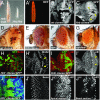Modulation of the Hippo pathway and organ growth by RNA processing proteins
- PMID: 30257938
- PMCID: PMC6196505
- DOI: 10.1073/pnas.1807325115
Modulation of the Hippo pathway and organ growth by RNA processing proteins
Abstract
The Hippo tumor-suppressor pathway regulates organ growth, cell proliferation, and stem cell biology. Defects in Hippo signaling and hyperactivation of its downstream effectors-Yorkie (Yki) in Drosophila and YAP/TAZ in mammals-result in progenitor cell expansion and overgrowth of multiple organs and contribute to cancer development. Deciphering the mechanisms that regulate the activity of the Hippo pathway is key to understanding its function and for therapeutic targeting. However, although the Hippo kinase cascade and several other upstream inputs have been identified, the mechanisms that regulate Yki/YAP/TAZ activity are still incompletely understood. To identify new regulators of Yki activity, we screened in Drosophila for suppressors of tissue overgrowth and Yki activation caused by overexpression of atypical protein kinase C (aPKC), a member of the apical cell polarity complex. In this screen, we identified mutations in the heterogeneous nuclear ribonucleoprotein Hrb27C that strongly suppressed the tissue defects induced by ectopic expression of aPKC. Hrb27C was required for aPKC-induced tissue growth and Yki target gene expression but did not affect general gene expression. Genetic and biochemical experiments showed that Hrb27C affects Yki phosphorylation. Other RNA-binding proteins known to interact with Hrb27C for mRNA transport in oocytes were also required for normal Yki activity, although they suppressed Yki output. Based on the known functions of Hrb27C, we conclude that Hrb27C-mediated control of mRNA splicing, localization, or translation is essential for coordinated activity of the Hippo pathway.
Keywords: Hippo pathway; Hrb27C; RNA-binding proteins; aPKC; hnRNP.
Conflict of interest statement
The authors declare no conflict of interest.
Figures





Similar articles
-
The Hippo pathway integrates PI3K-Akt signals with mechanical and polarity cues to control tissue growth.PLoS Biol. 2019 Oct 15;17(10):e3000509. doi: 10.1371/journal.pbio.3000509. eCollection 2019 Oct. PLoS Biol. 2019. PMID: 31613895 Free PMC article.
-
Differential regulation of the Hippo pathway by adherens junctions and apical-basal cell polarity modules.Proc Natl Acad Sci U S A. 2015 Feb 10;112(6):1785-90. doi: 10.1073/pnas.1420850112. Epub 2015 Jan 26. Proc Natl Acad Sci U S A. 2015. PMID: 25624491 Free PMC article.
-
Mask is required for the activity of the Hippo pathway effector Yki/YAP.Curr Biol. 2013 Feb 4;23(3):229-35. doi: 10.1016/j.cub.2012.12.033. Epub 2013 Jan 17. Curr Biol. 2013. PMID: 23333314 Free PMC article.
-
A role for Hipk in the Hippo pathway.Sci Signal. 2013 May 14;6(275):pe18. doi: 10.1126/scisignal.2004259. Sci Signal. 2013. PMID: 23674821 Review.
-
Disease implications of the Hippo/YAP pathway.Trends Mol Med. 2015 Apr;21(4):212-22. doi: 10.1016/j.molmed.2015.01.003. Epub 2015 Feb 18. Trends Mol Med. 2015. PMID: 25702974 Free PMC article. Review.
Cited by
-
Discordant interactions between YAP1 and polycomb group protein SCML2 determine cell fate.iScience. 2023 Sep 20;26(10):107964. doi: 10.1016/j.isci.2023.107964. eCollection 2023 Oct 20. iScience. 2023. PMID: 37810219 Free PMC article.
-
Hippo pathway and Bonus control developmental cell fate decisions in the Drosophila eye.Dev Cell. 2023 Mar 13;58(5):416-434.e12. doi: 10.1016/j.devcel.2023.02.005. Epub 2023 Mar 2. Dev Cell. 2023. PMID: 36868234 Free PMC article.
-
Effects of Spaceflight and Simulated Microgravity on YAP1 Expression in Cardiovascular Progenitors: Implications for Cell-Based Repair.Int J Mol Sci. 2019 Jun 4;20(11):2742. doi: 10.3390/ijms20112742. Int J Mol Sci. 2019. PMID: 31167392 Free PMC article.
-
Rox8 promotes microRNA-dependent yki messenger RNA decay.Proc Natl Acad Sci U S A. 2020 Dec 1;117(48):30520-30530. doi: 10.1073/pnas.2013449117. Epub 2020 Nov 17. Proc Natl Acad Sci U S A. 2020. PMID: 33203680 Free PMC article.
-
Emerging Roles of RNA-Binding Proteins in Neurodevelopment.J Dev Biol. 2022 Jun 10;10(2):23. doi: 10.3390/jdb10020023. J Dev Biol. 2022. PMID: 35735914 Free PMC article. Review.
References
Publication types
MeSH terms
Substances
Grants and funding
LinkOut - more resources
Full Text Sources
Other Literature Sources
Molecular Biology Databases

